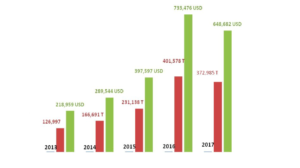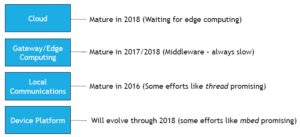‘We are seeing work with clients today which is very much around big data and robotic process automation (RPA), where in compliance — take anti-money laundering — you can take out thousands of roles,’. ‘That is coming quite quickly now and that will sweep across the industry.
Companies have really thrown bodies at this to deal with the demands of the regulators. They have had no option,’ ‘But now we are shifting from a revolution of labor arbitrage and offshore to a revolution of automation around this.’
- Richard Lumb, Head of Financial Services at Accenture, quoted at the World Economic Forum by the Financial Times.
Among the many ‘mini-revolutions’ moving through IT services, robotic process automation (RPA) is among the most significant, as the statements above demonstrate. Lumb says that many of the jobs created by banks in recent years for compiling and checking data on customers and transactions had already been moved offshore to lower-cost countries. In the next wave of automation, these jobs may simply disappear.
RPA in Action at Global Banks
Last July American Banker reported that BNY Mellon had introduced RPA into its operations in order to lower costs. “We’ve been piloting robotics and machine learning processes to automate work and eliminate repetitive manual tasks,” said BNY Mellon CEO Gerald Hassell during the bank’s second-quarter conference call. “It’s really taking some of the manual mind-numbing exercises out of the process and doing it at a lower cost.”
BNY Mellon’s experience was a bellwether for what was discussed by financial firms during the World Economic Forum at Davos. During a panel on the future of banking, the rise of fintech and the possibility of virtual currencies, John Cryan, CEO of Deutsche Bank talked about the critical role technology will play in the immediate years ahead, as banks strive to reduce costs and execute processes and services in the efficient manner that customers and clients have come to expect.
Cryan specifically acknowledged the benefit of implementing technology to manage and monitor internal oversight. “We can use technology to improve our own controls. We can use technology to improve our efficiency and then we can use technology to improve the customer service,” Cryan said.
A recent Citibank report states that the banking industry spends $270B – or approximately 10 percent of operating costs – on the handling of compliance and regulation, much of which involves manual work to comply with oversight rules. Citi also estimates that European and US banks have paid more than $150B in litigation and conduct charges since 2011, a figure that the industry no doubt hopes to lower through the use of RPA.
It’s not only financial services that are benefiting from RPA. Among the examples cited by Gartner of front-, middle-, and back-office deployments of RPA include:
- Human Resources tasks such as employee onboarding, recruitment and payroll. RPA is being used to coordinate different types of requests that need to be made when an employee joins a firm — from notifying payroll, to granting IT access and passwords, to having a desk. The benefit to the firm is that one system can be linked to multiple other systems and can eliminate rekeying of data between the systems when looking at the entirety of the activities that a starting employee requires.
- Customer Management. RPA aids with onboarding, processing rule-based activities triggered from websites, interactive voice response (IVR) systems, web chat and mobile apps, collating data from multiple disparate systems for customer service, orders, and checking systems for price and delivery offers. The benefit of adding in an RPA tool is that customer-service employees can more quickly access all necessary data – including that from the legacy systems of companies acquired in the past.
- Finance and Accounting. Checking correct input of invoice or order entry data, and collating of reporting data from multiple systems for month- and year-end reports are among the ways organizations use RPA for finance and accounting. The benefit here is that the RPA tool can run a “soft close” each day and alert managers of potential problems.
RPA Impacts Service Providers as Well
RPA is also playing havoc with the business models of Indian pure-play companies. While most large, global IT services providers are facing a steady decline in revenue, the India-based firms have resisted this trend with their wage-arbitrage/”bums-on-seats” strategy. That strategy, however, is facing significant challenges in a Cloud-centric, Digital world, and labor-cutting RPA processes will only add to the woes of India-based firms.
Among larger global competitors, Accenture and Blue Prism announced in January that they are working together to provide RPA solutions for clients across industries. ‘More than 40 organizations have already selected Accenture and Blue Prism to help achieve this, including international retailer Circle K and Raiffeisen Bank International’, according to Horses for Sources (HfS).
Although not often considered a traditional IT service provider, Deloitte is the strongest riser in the HfS RPA Premier League Table (see below) and this is the type of offering that fits with the firm’s holistic transformation agenda. Specifically, Deloitte is combining its strong client traction across verticals with a shared services development platform out of India. For RPA, Deloitte is pursuing a partner ecosystem approach with the leading RPA vendors, while adding its own Cognitive Automation capabilities.
EY, meanwhile, says ‘RPA will quite quickly convert from a differentiator delivering a competitive advantage to a standard practice that needs to be followed for survival’. EY has embedded RPA into its broader Smart Automation Framework, with a strong focus on transformational projects that move clients toward self-service and CoEs. At the same time, EY emphasizes its close partnership with Blue Prism. Overall, PwC estimates that 45% of work activities can be automated, and that this automation would save $2 trillion in global workforce costs.
For its part, NTT Data’s Automated Full-Time Equivalent (AFTE) helps automate repetitive, high volume and rules-based tasks with a suite of more than 50 tools to meet a wide variety of industry and business needs. NTT (who acquired Dell Services in December 2016) combines RPA with a command center.
According to NTT Data:
- ‘With the emergence of robotic process automation technologies, the business process outsourcing industry is able to do more than ever before. But without the ability to measure efficiency and oversee the entire automation cycle, it can be difficult to sustain long-term strategic growth.’
- ‘To help you fully control, understand and analyze the efficiency of AFTE, we offer a command center featuring real-time statistics, performance monitoring and analytical capabilities. The NTT DATA AFTE Command Center maintains a fully auditable record and monitors the effectiveness of machine-based work. It aggregates tasks, assesses cross-process penetration levels and distinguishes between machine- and human based tasks.’
(For more on command centers, see the blog “Why we need to become better listeners – The case for a command center approach”).
The larger providers noted above are not the only companies exploring RPA. Horses for Sources (HfS) identified some pure play companies in its 2016 RPA Premier League Table (see below). These smaller organizations are the vanguard of deploying RPA based on their technical expertise. HfS expects that most of them will be absorbed by the leading management consultancies over the next 18 months. We shall see.
Gartner in its Forecast Snapshot: Robotic Process Automation, Worldwide, 2016 report, forecasts the robotic process automation software market ‘will grow by 41% year over year to 2020. Technology product marketing leaders must plan for most growth coming from new deployments, though this growth will be tempered by next-generation AI products.
‘Key Findings
- By 2020, end-user spending on robotic process automation (RPA) software will reach $1 billion, growing at a compound annual growth rate (CAGR) of 41% from 2015 through 2020.
- By 2020, 25% of organizations using RPA will have two or more RPA software tool types deployed and multiple artificial intelligence (AI) tools.
- By 2020, RPA tools will have evolved to include more types of functionality, such as AI software, but will experience strong downward pricing pressure.
- By 2020, 40% of very large global organizations will have adopted an RPA software tool, up from an estimated less than 10% today.’
At the 2nd Annual Robotic Process Automation in Shared Services Summit in Chicago in 2016, Swetal Desai, Vice President of Business Process Improvement at HP Enterprise said:
- Robotic Process Automation is no longer a hype
- RPA should not be run as a technology project; but, a business transformation priority, part of more comprehensive long-term company strategy
- Process thinking (Eliminate/Simplify/Standardize/Automate) is critical and drives bigger ROI
- Selecting right processes to automate is key
- The market, technology and vendors are evolving…stayup-to-date.
- Don’t try to align processes to a RPA software; Invest in partners/products which are capable to automate the most. There are no “do it all” RPA suites.
- No one team can do it….it requires management of complex ecosystem of players–business stakeholders, technology and development partners, internal IT organization, Process excellence teams and Finance
- Do not under-estimate the Management of Change challenges and impact on workforce
The evolution of Intelligent Automation in general and RPA, in particular, is one of the most disruptive shifts our industry has witnessed. 2017 will be the year that RPA really shakes up the industry as the labor arbitrage business model is finally laid to rest. RIP.


